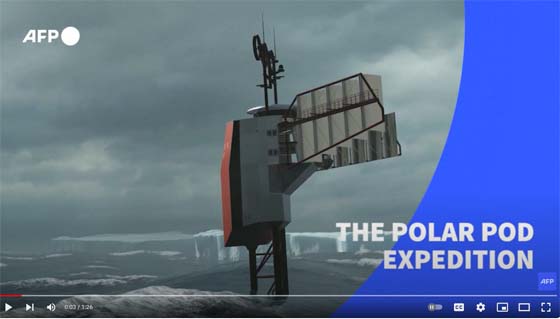 We recently posted about the remarkable 61-year career of the one-of-a-kind research vessel FLoating Instrument Platform, known as FLIP. FLIP was essentially a massive 355-foot-long spar buoy used to study oceanic wave height, acoustic signals, water temperature, and density.
We recently posted about the remarkable 61-year career of the one-of-a-kind research vessel FLoating Instrument Platform, known as FLIP. FLIP was essentially a massive 355-foot-long spar buoy used to study oceanic wave height, acoustic signals, water temperature, and density.
Now, if all goes to plan, the Polar Pod, a new oceanographic research station in the form of a ‘vertical ship, inspired by FLIP, will commence operations in the Southern Ocean from 2024-2026.
In orbit around Antarctica, the Polar Pod will be carried along on the circumpolar current, and will circle the earth between 50 ° and 55 ° S.
This circumnavigation of 24 000 km, at the average speed of 1 knot (1.8 km / h) should last 2 years. Subject to headwinds and adverse currents, the Polar Pod will not follow a straight line.
The Polar Pod is equipped with a transverse propeller, 10m below the waterline, as well as steerable sales, enabling the crew to maneuver away from icebergs. Crews will be relayed every 2 months using an offshore supply type, which will be permanently assigned to the mission.
The Polar Pod was developed as part of an initiative led by France’s National Centre for Scientific Research (CNRS), National Centre for Space Studies (CNES), and Research Institute for Exploitation of the Sea (Ifremer), with the goal of sharing data with the global scientific community on the Southern Ocean’s interactions with the atmosphere, current dynamics and biodiversity.
As described in a recent article by the Royal Institute of Naval Architects (RINA), the design was selected instead of a more ‘conventional’ ship shape so that the Polar Pod’s complement can work safely and in comfort in the face of the ‘Furious Fifties’ – the gale-force winds that howl through the southerly latitudes. “One needs a ship with a strong draught, caught in deep stable waters, and a small surface at the impact of the waves,” says Ifremer. “The architecture is designed not to resonate with the swell: its period of heaving, from bottom to top, is 60 seconds, while the swell of the great South is close to 20 seconds.”
Stability-wise, the Polar Pod is designed for 5° heel in the Southern Ocean’s harsh conditions, plus “a vertical movement that does not exceed 10% of the height of the waves”, Ifremer adds.
The Polar Pod measures just over 100m in height; has a 75m draught, for optimal stability; and weighs 1,000 tonnes – which, combined with a tough outer steel shell, should enable it to withstand violent storms. Ifremer continues: “The legs of the lattice are made of steel, from 1.5-2″ [38-50mm] thick, and the bottom ballast weighs 150 tonnes.”
The Polar Pod will harvest wind energy from six Kingspan turbines, each rated 3.2kW, complemented by solar panels. This combined green energy will then be stored in twin 50kWh lithium-ion battery packs and used to power the Pod’s scientific equipment, onboard lighting, IT/comms systems, water desalination plant and onboard heating.
Thanks to Roberta Weisbrod for contributing to this post.

